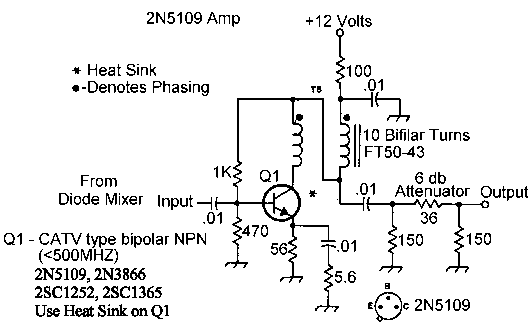



|
This amplifier follows the front end mixer and provides proper termination to the mixer without having to use a diplexer. From the ARRL 1986 Handbook, page 30-9, gives the specifications for the amplifier - "Amplifier gain, including the loss of the pad, is about 16 dB. The mixer has a loss of about 6 dB, leaving a net module gain of 10 dB. The amplifier output intercept is about +30 dBm." The transistor used in this circuit must have a high frequency response - 500MHz or better. A couple of substitutes are the 2N3866 or the 2SC1252. In my opinion, this amplifier is a fantastic circuit. Everyone I have built (20+ all done "dead bug" type construction) have worked perfect first time power was applied. It is stable as a rock and even with power applied and no terminations on the input or output, will not self-destruct. I have also used it as a VFO amplifier to drive old tube transmitters and can be used (with an appropriate bandpass filter) as a final for a QRP transmitter (without the 6dB pad, of course). This circuit is becoming one of the most popular post-mixer amplifiers in the high-performance receivers that are currently being published in the ham radio literature. ReferencesThe 2N5109 amplifier can be simulated using the Serenade SV program. Information on using the program and simulating the amplifier can be found at "Simulating Circuits and Systems with Serenade SV", by David Newkirk, W9VES, January 2001, QST, Page 37. The file for the amplifier is SerSV0101.ZIP at http://www.arrl.org/files/qst-binaries/ The Ansoft Serenade SV program can be downloaded at http://www.ansoft.com/about/academics/sersv/index.cfm |

Send E-Mail || Amateur Radio Receivers || Super Receiver || Super Receiver Circuit Details
